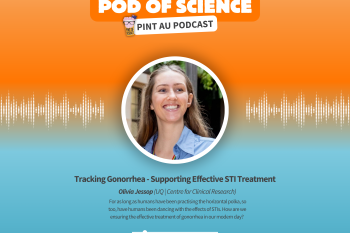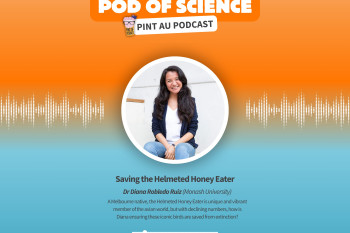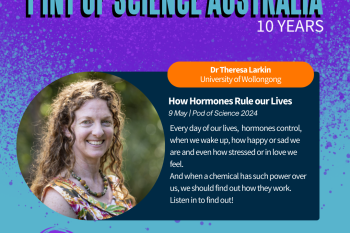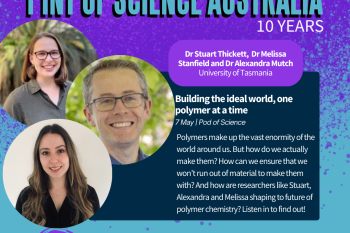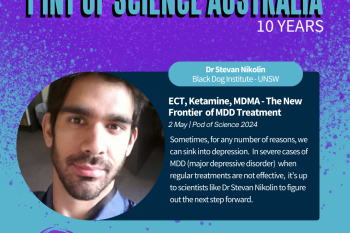© Pint of Science, 2025. All rights reserved.
What if a building could help improve our mental health? Isabella Bower is investigating what makes for good design and how we can use these to get the best out of our built environment.
~~
Transcript
Camille Thomson: We're here with another episode of Pod of Science and I'm here talking to Bella Bower. How are you today, Bella?
Isabella Bower: Great thanks Camille. How are you?
Camille: I'm really happy that we're getting into these podcasts again. Could you just tell us in a couple of points a little bit about the work that you do?
Isabella: Yes, sure, so my background’s in architecture and the built environment. I've trained to be an architect, but I was really interested in how buildings affect our emotion and what the kind of psychological side of design is. So what my work is around is trying to measure our emotional and neuro physiological response to interior built environments.
Camille: Wow, so you actually trained to draw buildings and everything as an architect?
Isabella: Absolutely, and to evaluate buildings and we have post occupancy evaluations in architecture and built design. So you go, you build the building and then you ask the occupants how they feel about the building, how it works, and you try and evaluate whether it was a good build or not, whether it met the brief or not. But it would just be amazing if we could get in a bit earlier and design these buildings, making sure that they are protecting people on that invisible psychological side. But how to do that's really complex, because people are so complex, our lives are so complex as well. So, trying to put that into an experiment means that you've got to really make sure it's quite context neutral so you don't have, say, perhaps a bad experience influencing how you're feeling about the space. To know whether it is actually the space influencing you or actually a former experience.
Camille: So what kind of factors are you looking at in an architectural space that could affect a person or a group of people that are using the space?
Isabella: I've broken it down to some very basic design characteristics just to get a baseline. I first, broke it down into colour, geometry, texture, and scale. I started with changing the scale of the space so making it bigger and smaller and seeing if that affected people, and then I threw in a colour as well to see if the colour changed, how they responded.
Camille: So, what kind of colours did you use?
Isabella: I use blue actually, and there's a bit of work that's been done on blue and how that affects us, so that was an interesting one to throw in. That was very much a pilot work study compared to the scale of the space, but it did elicit a different response from participants.
Camille: That's amazing, fantastic. So, what kind of impacts do you think this work could have on the architectural profession, but probably on buildings as a whole that we could see it going forward?
Isabella: Yeah, it's a really big one because it affects everyone in the population in such a wide context, so I'm not just looking at say, a hospital design and a hospital building. I'm really looking at the underlying design characteristics of every single building out there for designers and planners of the built environment. At the moment, we do have advocacy around what good design is, and we have the Office of the Victorian Government architect that really fight for having good design. The amount of architects and designers that are involved in a lot of the builds, especially houses, it's not very many at all. So, if we had evidence around what good design was and what good design is, in that psychological sense too, it might mean that we can really fight for having really well-designed buildings. To make sure that it's just another, perhaps a neuroprotective factor in the end. It would be really great if it was like a passive way of influencing people's health and wellbeing and making sure everyone was in a really supportive space.
Camille: Yeah, I guess you spend a lot of time in lots of different buildings in your day. You know not just where you live, but where you work and where you shop. Do you think materials have an effect on what people might deal with? Say you know, going through a shopping centre with Lino and cement as opposed to carpets for example.
Isabella: Yeah, absolutely. So we spend 80 to 90% of our time indoors so it's in terms of science wise, that's a huge exposure that we have. And when you look at animal studies looking at how their environment itself affects the animals, that was a huge turning point in neuroscience. It was called environmental enrichment and there's a few components of that. There's the social side, the diet side, the exercise side. But also the actual physical space, that made a huge difference to animals. So why wouldn't it make a huge difference to us as well. The tricky part about those real-life settings is that there's so many elements within them. There's heaps of different colours, heaps of different scales, textures and everything, so trying to put that in to an experiment, it is very tricky. But what I'm trying to do is look at those individual characteristics, then see do they influence each other. So is there interactions between colour and scale when you pop them together? Does it make a difference if you put people in the space as well? And if someone’s close to you does that then change your response? Even if it's the scale as well. So there are quite a few factors that are at play there, but if the built environment does have this power to change how we feel, then that's something we really need to know about and we need to make sure it's having a good effect on us, not a bad effect.
Camille: Definitely. We’ve got to spend our time in good places. So what are some of the obstacles? I know you've mentioned a few things about getting experiments together and things like that. What are some of the really big obstacles you come across or you can foresee are going to be an issue in getting this research progressing.
Isabella: I think interdisciplinary research in general is a little bit tricky, especially in the systems at the moment. So, you've got knowledge from these different sides and they need to communicate with each other and have that same language and get across to each other, just to connect like that. That's always a challenge, and it's sometimes a challenge that can take time as well, so publishing might take a little bit longer because you need more experts involved in evaluating that manuscript, so it takes longer to publish the article, which in turn means that the research moves a little bit slower. That person may not get funding granted because of that and as a result. So absolutely investing in interdisciplinary research, that's really important. I think it's a buzzword and everyone says it's a great thing to do and it is a great thing to do. But just making sure our reward systems do reward interdisciplinary research because it is where we can really have those breakthroughs because people are working together and this exciting knowledge from each side is coming together to discover something new.
Camille: So what kind of different researchers or different people have you been working with in this area that you're working on? Obviously you've got some background, but there are other people you kind of pulled into fish their brains?
Isabella: Absolutely. Cognitive neuroscience, psychology is a big side of this. I did training in psychology and that area to be able to understand how to measure and record and interpret brain waves. Then there's also engineering as well. So part of my experiment was using virtual reality. And the reason I use that was because I could immerse someone in space where I could completely construct the space. I could make sure it was devoid of other characteristics, so I was really controlling what that exposure that they were immersed into was. I then had to build that with them, game designers and engineers as to what that stimulus looked like. So it's a bit of engineering, built environment and neuroscience coming together.
Camille: Some very disparate fields there, but it's great to hear. So what do you think will be the outcome from your research? What would you think that the next generation, I know you're quite early in your career, but what will the next generation of researchers coming behind you, what would you like them to be working? Or what would you hope you can achieve?
Isabella: I'd love this research just to be the very start of. That we can measure this. That people accept that we can measure emotional neurophysiological response and we can build up the complexity of the experiment. So instead of just looking at one element, we can start looking at complexities within design and we can look at buildings before they get built and evaluate them. See how they make a range of different people feel. Understand if different people’s personalities mean that there's different preferences and we need to accommodate multiple things within the design process. So when we invest in building a building, we know that it's going to work really well before it's actually built. And we put the money and time and embodied energy into creating it. And what would be really cool I think is if those in architecture school and urban planning that are learning the discipline that they apply psychology and neuroscience within their courses, that would be fantastic. To see that happening really early on. So people knew that when they were drawing on the paper what the plan would be like, and they're thinking about that human experience. They then go and have a look at the literature and go, “Oh well, that might do this” Or “That might do that and we can support this person in this way”. So if that was all embedded into the curriculum, that would be amazing.
Camille: Fantastic. So do you have a favourite building? This was what I was really keen to hear.
Isabella: I do have a few different favourite buildings, but for me the favourite buildings come from what I need at the time. So if I'm feeling quite vulnerable or nervous before something I'd like a space that's got warm lighting and it's a little bit smaller scale, so I feel enclosed and comforted. And I usually like having my back protected so I don't like having people walking behind me where they can look over my shoulders. So having that sense of security. So it actually depends on my emotion at the time as to what is my favourite elements within a building. There’s certainly absolutely beautiful buildings that they just inspire a sense of awe. I'm thinking of the Salk Institute, which I haven't been to. But this was done by Louis Kahn working with Jonas Salk to build this beautiful lab that when the sun just kind of lines up with the building, it's absolutely beautiful. Just from the photos. But what that experience is another thing too, so I would say yeah, there's a few different favourite buildings, but it depends on my emotions at the time.
Camille: Definitely. It’s like all of us, we have how go-to place
Isabella: Absolutely.
Camille: So we're going to take a step out of your specific area of research and sit a little bit wider, and say what do you think is the biggest challenge facing science as a whole right now?
Isabella: For me, I think it's the instability. So the environment there's not much security as to how long term, especially for younger researchers, your contract will be. And that can be detrimental to mental health and career progression. So I think having more security with it and having more funding available is probably where I see the challenge is. Hopefully that we will get over that. We will have more investment and funding in science because it is really crucial. Which I think is being highlighted at the moment.
Camille: Do you have, I guess, do you think that there is, not a magic bullet, but do you think that there’s a formula that might get people more interested in the benefits of science? Those people who aren't doing the STEM careers, but, as you say, holding the money. Do you think there’s a magic formula that we could do to get them more interested in making sure the funding goes towards those things we need for the future, not just for now?
Isabella: Yeah, that's a really fantastic question. I think it's so complex that's probably why we don't have the magic answer to it yet. The good thing is everyone, when I speak about the research that I do and research that other people do in this area, everyone's really excited about it and they do want to see it happen. That's fantastic. At a curriculum level, I know when I went through architecture school, I didn't know that research or doing a PhD was even a career option for me. So research in architecture is just, it's something that's not discussed enough and I think the discipline itself because it’s at the cross edge of the humanities and social sciences and the STEM sector. It's a little bit confused and as a result sometimes people don't realize what those opportunities are. So seeing more people in architecture and getting research methods and research really embedded into the curriculum will help get more people through the system. But then it is that case of having the funding available and the support there in the institutions and from government and from industry to make it happen.
Camille: Yeah, I think the industry is going to be the big one. Going forward is where that push is gonna come in a lot of sectors. So, fingers crossed we’ll emerge from this scenario stronger and more excited about science. So I’ll came away from the seriousness of science funding, which we all know is going to be an ongoing discussion. And, well, I just wanted to ask you why did you choose to be part of the Pint of Science Festival?
Isabella: Yeah, I started last year, only last year, so this is my second year with Pint of Science.
Isabella: And I was lucky enough that one Pint volunteer came up to me when I did my 3 minute thesis and said “Hey you should really get involved with Pint of Science.” It was that and also watching my friends present at Pint of Science that that really hooked me into it. So I thought “Wow this is fantastic! Early career researchers they're getting this chance to build up their skills and their knowledge and presenting their science.” It's getting out to the public, which is just fantastic. That's the point of research. There's no point in writing a paper, and it goes nowhere. That's really silly. You really want it to get out there and for people to discuss it and to be excited about it. And so we have that investment in science as well. So for me, it's a win-win of it being a fantastic thing to do to develop your skills, but also to get other people in the community excited.
Camille: Yes, definitely the one big kind of benefit of Pint of Science. And how have you felt about communicating your science in the last year or so where the face-to-face communications probably haven't happened very much or at all? And when obviously online formats for a lot of things have been easier. Is it harder, has it brought out new skills?
Isabella: It's trickier in some senses, because when you're in front of a crowd while that's very nerve wracking, you can really get the vibe from the audience. So you can have a look at their body language, see if people are engaging with you or not, or if you're just completely off the track with the language that you're using or the story that you're telling. Whereas online, if you're not seeing people's faces and sometimes people do turn their cameras off, or if it's for radio or podcast, you're not sure how you're going to be interpreted, so you're hoping it will go well, but you don't have as much direct feedback. So it's been a different experience.
Camille: Yes, I think we will kind of found that, it's a new set of challenges, we're all going to get across this communicating science. Well, it's been really lovely talking to you and about what you're doing with buildings, and I can't wait to step into one that has been a fully researched space and feel exactly how the builder wanted me to feel inside the space and exactly what I needed. And I hope that we can all get back to the pubs and bars soon. You have been listening to a Pod of Science, part of Pint of Science Australia. You can catch up on past episodes at Spotify and SoundCloud. Don't forget to support your Pint of Science Festival at pintofscience.com.au
